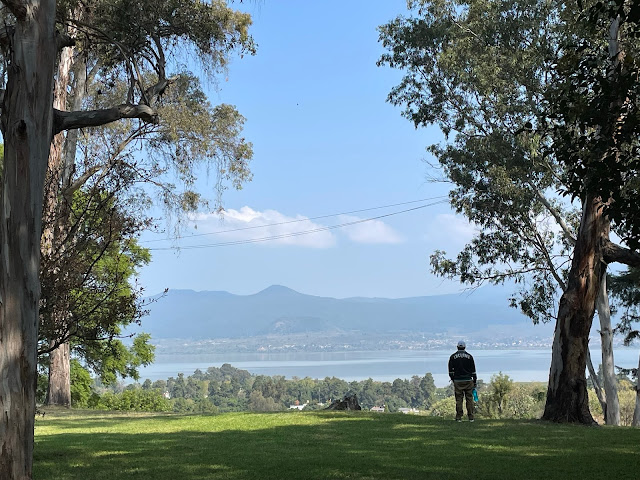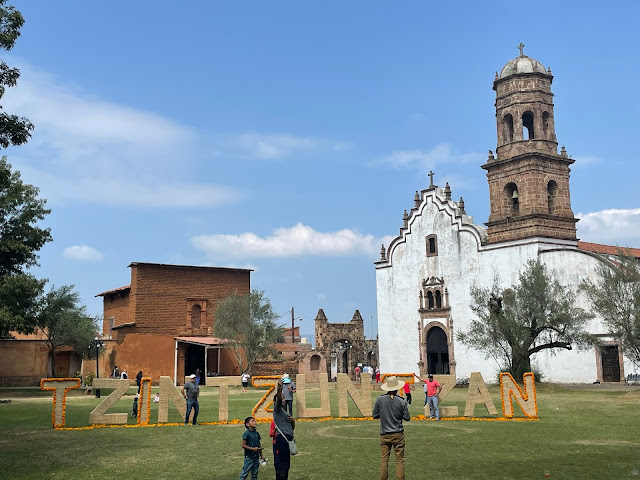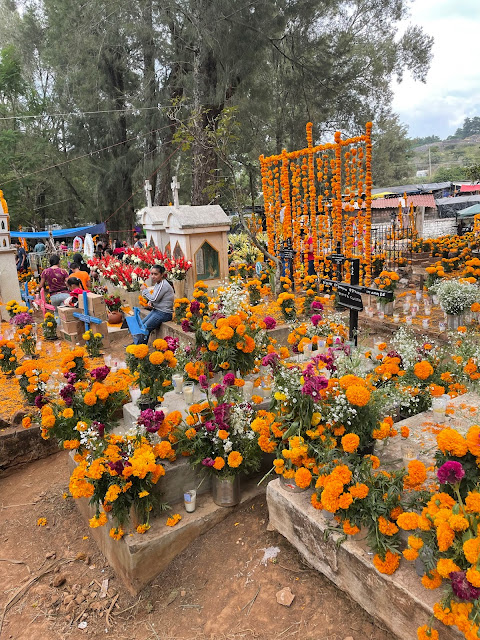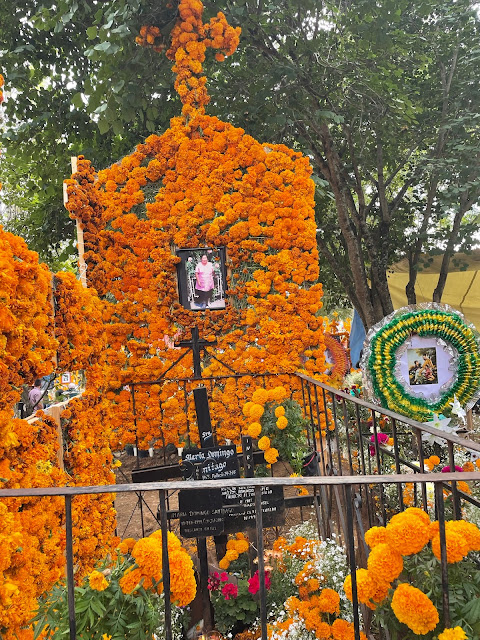Wednesday Tzintzuntzan, Quiroga, Santa Fe de la Laguna
After breakfast, we head back towards Patzcuaro to the town of
Tzintuntzan. When the Spanish arrived
this was the main center of the Purepecha people and continues to be one of the
towns that keeps to the traditions of Dia de Muertos. People were already gathering when we arrived
at about 10:30. We drove up the hill to
the archaeological site. Usually we’re
the only ones there but today there were student groups and several
families. The site is on a natural hill
overlooking the lake and the current town.
They added rocks to make a large portion of the hillside flat. This is where there are 5 yacatas in a row.
The represent the 4 cardinal directions and the present spot where one is. On the lake side, they are rounded but
connect to rectangular shapes that face the hillside. The construction is the same as we saw
yesterday – interior rubble, outer small regular stones, cut outer stones that
are about 4 inches thick. The outer
layer was covered with a stucco paint which would have been painted with bright
colors – mostly red. The hillside of the
structures had stairways leading to the top of each of the yacatas that would
have been used by the spiritual leaders. The upper class had palaces on the hillside of
the yacatas. There were also granaries. The site museum is small but has some nice
pottery pieces.
Philipe was able to maneuver through back streets to get us
down from the site and close to the entrance to the church and convent. The church was one of the first ones built by
the Spanish and is about 500 years old.
The native people were used to having their rituals outside so the
Spanish built large atria to gradually get the native people comfortable with
Catholic ritual. The Spanish planted
olive trees in the atria which still survive.
The convent is now a museum. The
church is most famous for the “growing Jesus”.
The legend is that the figure of Jesus that is in the glass casket has
grown so they have had to make an
extension in the casket to accommodate the “growing Jesus”.
Stones were taken from the archaeological site to originally build the convent. Some of them have carvings on them. This is how they are now.
 |
| Michelle inside one of the 500 year old olive trees. |
Wynne in an olive tree.
The streets are filling up and are lined with food stalls, and people selling marigolds. We walk a block to the entrance of the cemetery.
Many people have been sitting vigil by the graves of their loved ones all
night. There is evidence of the fires
that were built to keep them warm during the night. There is music, and a few speakers. This is certainly where the traditional Dia de Muertos is
still being celebrated.
It’s getting to be lunch time and we get back in the bus to
go to the town of Quiroga, famous for the style of carnitas. They use all of the parts of the big and
roast it all together into a tender lusciousness. One side of the square is crammed with stands
selling carnitas and people perched on stools eating them. We choose the restaurant, El Rey, which is on
the square and we can easily sit together and order other things as well for
the non-meat eaters in the group. There
is cactus soup, guacamole, beans, quesadillas to go along with our kilo of
carnitas. Yum!
The square of Quiroga has a nice bandstand with a large
catrina watching over it. Many people
are sitting on the benches watching the world go by.
Next stop is Santa Fe de la Laguna which is the town that
was used as a model for the movie “Coco.”
It has many more visitors now than before the movie.
Dinner tonight was much better than the one last night that
was all beef, beans and lots of onions.
Tonight we were able to eat a restaurant that I’ve been trying to get
into since we got here. It takes the
local foods and raises them up to a higher level of sophistication. I had trout with a macadamia nut
topping.

































No comments:
Post a Comment